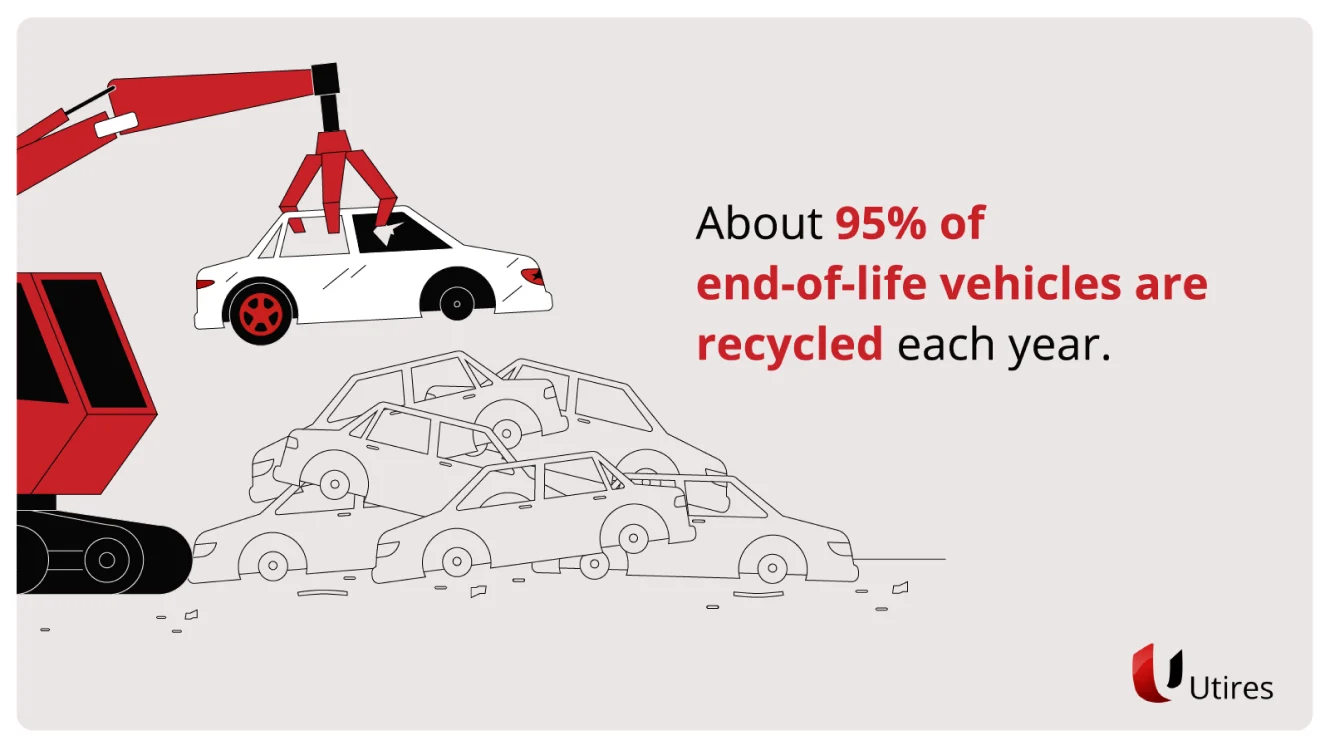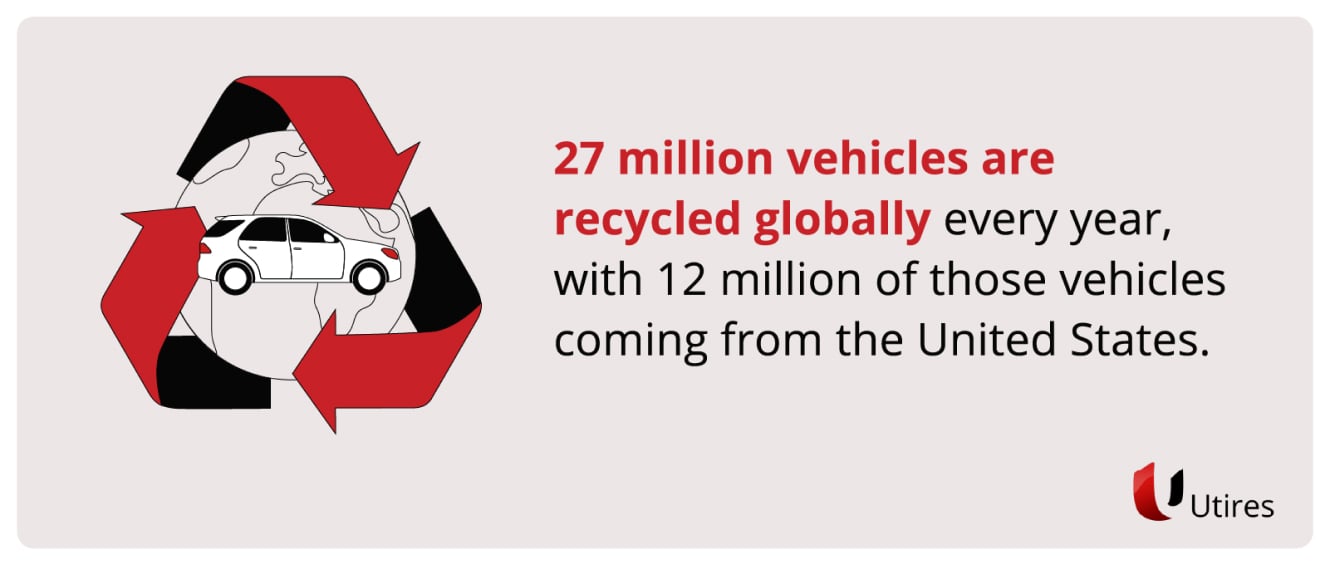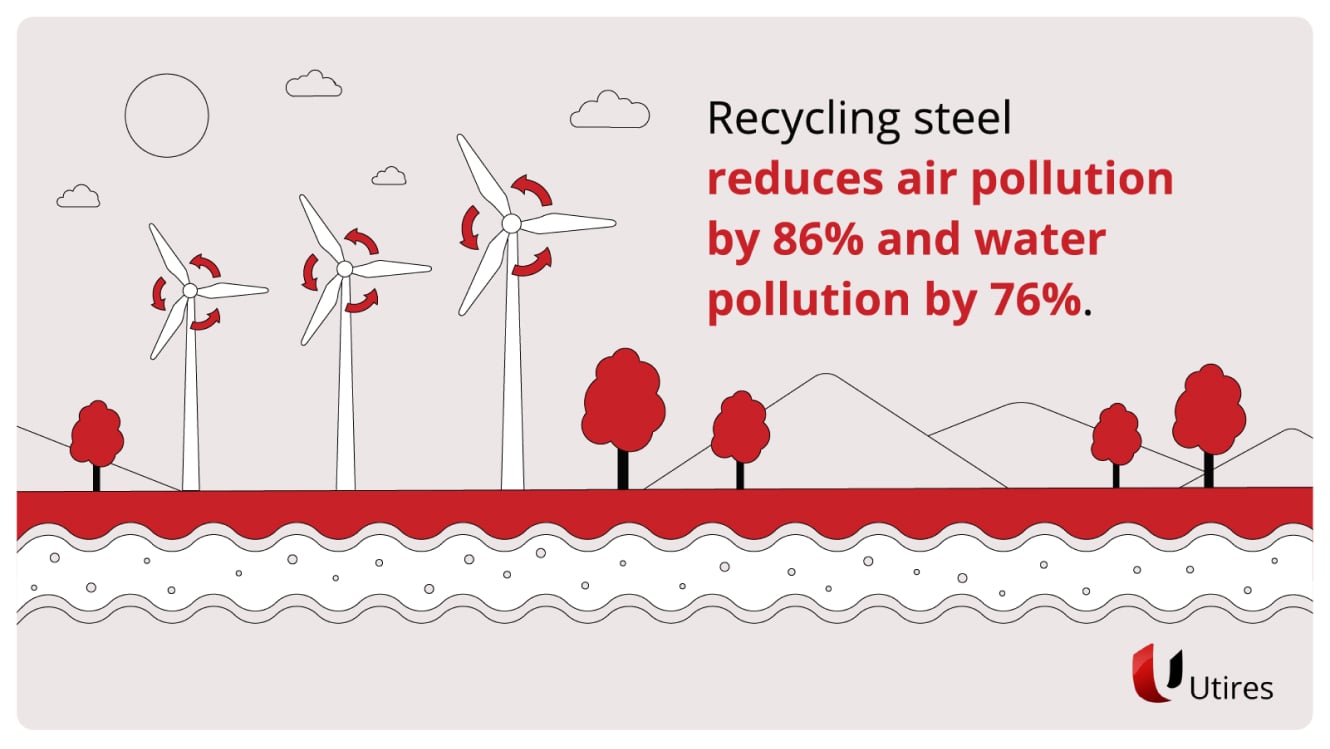Last Updated on 02.10.2024 by hrushetskyy
Recycling isn’t just important to conserve resources, it’s also vital for Earth’s sustainability. And eco-friendly practices can go far beyond reusing water bottles or upcycling glass. For instance, did you know thousands of parts found in automobiles can be recycled?

How Are Cars Recycled?
In the past, junkyards would simply take in old vehicles, with any unsold or unused parts left to gather dust or be discarded in landfills. Today, however, the approach has evolved significantly.
Now, as cars reach the end of their lives, most don’t go to waste. Instead, auto recyclers break them up and reuse their pieces.
- Vehicles are the most recycled objects in America.[2]
- Fully 86% of auto parts are recyclable.[1]
Amazingly, the majority of each car sent to recycling can be reused in some shape or form. Very little goes to a landfill. Materials such as steel, non-ferrous metals, plastic, and tires can be (and are) used to create other useful items. - About 95% of end-of-life vehicles are recycled each year.[2]
- 80% of car materials are reusable for other purposes.[2]
The automotive recycling industry has emerged as an important part of the overall system that contributes to sustainable practices. Automobile manufacturers are also working to make parts easier to remove when a car reaches the end of its life.
Every piece that’s easily removable and efficient to transform plays another small part in helping take care of the Earth. Scrap metal is a prime candidate for the recycling of auto parts. It’s versatile enough to be remade into all sorts of useful manufacturing and consumer products. Glass and tires can also be used in a variety of ways. For example:
- The lead found in a car’s battery can be recycled and used to make new batteries.
- Trained professionals can extract the sulfuric acid from old car batteries. They neutralize it and transform it into sodium sulfate crystals which, in turn, can be used to produce glass products and textiles.
Today, a huge effort goes into dismantling cars to use for spare parts. Industry experts say parts like these can be reused:
- Engines
- Transmissions
- Hoods
- Bumpers
- Fenders
- Tires
- Batteries
- Increasingly, computerized parts can be extracted and reused as well.[5]

How Many Cars are Recycled Each Year?
Like other industries pursuing environmentally friendly practices, automobile recycling continues to grow.
- Across the globe, millions of cars avoid a road trip to the landfill.
- 27 million vehicles are recycled globally every year.[2]
A huge global effort is underway to repurpose automobiles as more people across borders commit to preserving the environment and minimizing their carbon footprints. This effort also creates hundreds of thousands of jobs, bolstering economies across the world.
How Many Cars Are Recycled in the United States Each Year?
The United States is doing its part to help the planet. As noted above, car recycling is big business, and most autos are eligible for recycling. Here are some statistics:
- More than 12 million cars are recycled each year in the United States.[1]
- Approximately 26 automobiles are recycled in America every minute.[3]
- The car recycling industry ranks as the 16th largest in the U.S.[4]
- Aside from the 140,000 people this industry sector employs, it also contributes approximately $25 billion to the national GDP.[5]
Environmental Benefits of Auto Recycling
Not surprisingly, there are many environmental benefits associated with vehicle recycling. Materials such as steel and tires are highly useful, versatile, and reusable.
This lessens the environmental impact caused by the original manufacturing. It also widely expands process options.
Recycling Steel
Steel is one of the most coveted items that come from junk cars and is the main recyclable material.[1]
Recycling steel is environmentally important. And recycled steel performs similarly to new steel, which is why its recycling rate is so great.[1]
- Junk vehicles provide 14 million tons of recycled steel every year.[2]
- On average, approximately 25% of each new car is made using recycled steel.[2]
- Each year, the automotive recycling sector collects and melts down more than 18 million tons of steel.[1] This goes a long way toward environmental preservation.
- North America is doing its part. In the U.S. and Canada, the auto recycling industry yields enough recycled steel to build 13 million new vehicles.[4]

Manufacturing from recycled steel is much more environmentally friendly than producing new steel because it cuts pollutants and emissions.
Recycling Tires
Each year, tens of millions of tires are repurposed into a wide range of products. Many common items that we encounter regularly are made from recycled tires, including:[1]
- Mulch
- Playground surfaces
- Running tracks
Recycling Oil
- In all, 85 million barrels of oil are saved by recycling end-of-life vehicles, car parts, and car batteries.[3]
- In each car that’s salvaged for parts, approximately 5-10 gallons of liquids can be salvaged. These include:[2]
- Oil
- Coolant
- Windshield washer fluid
Here are a couple of other facts to consider:
- Left standing in a junked engine, these liquids will eventually leak, be absorbed into the ground, and contribute to water pollution. Multiply that effect by the tens of millions of cars that can be recycled each year: That’s a lot of fluid pollutants!
- Oil doesn’t wear out; it simply gets dirty and needs cleaning.
- Millions of oil barrels are saved by cleaning oil, which boosts energy recovery by reducing the need for new fossil fuels.
- The amount saved every year equates to eight Exxon Valdez oil spills.[6]
Recycling Glass
Automotive glass also is versatile enough to reuse and turn into such items as:
- Concrete blocks
- Glass bottles
- Countertops
- Worktops
- Insulation
- Jewelry[2]
One complication: Automobile glass is designed to prevent it from shattering in an accident. While this has saved lives, it also has made windshields difficult to repurpose. The glass is difficult to extract from the layers of plastic encasement that keep the windshield intact. However, new technology now makes recycling auto windshields possible.
- In 2016, Safelite AutoGlass recycled 1.76 million windshields, totaling 6 million windshields since the program’s inception in 2012.[7]
Recycling automobiles conserves natural resources and reduces pollutants. Between this and the other tangible benefits, such as jobs and contributions to a thriving economy, recycling cars at the end of their useful lives is a positive move toward sustainability.
Sources
[1]. Recycle Nation. “How Are Cars Recycled?” https://recyclenation.com/2018/03/how-are-cars-recycled/. Accessed June 1, 2021.
[2]. Cash Cars Buyer. “Automobile Recycling Stats: What Percentage of Old Cars are Junked?” https://www.cashcarsbuyer.com/automobile-recycling-stats-what-percentage-of-old-cars-are-junked/. Accessed June 1, 2021.
[3]. Junk Car Medics. “Automobile Salvage & Recycling Facts & Statistics [The Complete List],” https://www.junkcarmedics.com/automobile-recycling-facts-statistics/. Accessed June 1, 2021.
[4]. The Balance. “20 Auto Recycling Facts and Figures,” https://www.thebalancesmb.com/auto-recycling-facts-and-figures-2877933. Accessed June 1, 2021.
[5]. University of California Irvine Sustainability. “Vehicle Recycling: A Driving Force in Sustainability.” https://sustainability.uci.edu/vehicle-recyling-a-driving-force-in-sustainability/. Accessed June 1, 2021.
[6]. Advanced Remarketing Services. “Environmental Impact of Auto Recycling,” https://www.arscars.com/environmental-impact-auto-recycling/. Accessed June 1, 2021.
[7]. Recycling Today. “Safelite AutoGlass reaches windshield recycling milestone,” https://www.recyclingtoday.com/article/safelite-autoglass-windshield-recycling-milestone/. Accessed June 18, 2021.

